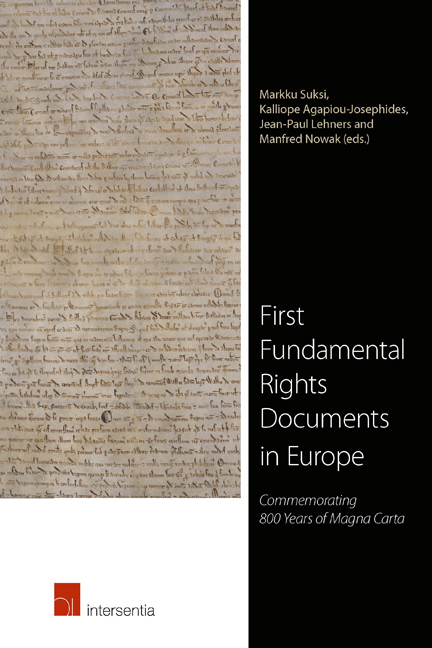Book contents
- Frontmatter
- Preface
- Contents
- List of Authors
- 1 Introduction
- PART I
- PART II
- 11 France: Foundational Importance of the Declaration of 1789
- 12 Sweden: Free Press as a First Fundamental Right
- 13 The Netherlands: The Batavian Staatsregeling as the First Fundamental Rights Document
- 14 Portugal: ‘Tropical Versailles’ in the Beginning of the Nineteenth Century
- 15 Luxembourg: Fundamental Rights in a Small State
- 16 Greece: Reflections from the Hellenic Legal Tradition
- 17 Denmark: In Love with Tradition
- 18 Germany: Fundamental Rights as an Instrument Towards the Rechtstaat
- 19 The Czech Republic: On the Road to Rights and Freedoms
- 20 Romania: The Birth of Fundamental Rights as a Form of Political Contention
- 21 Bulgaria: The Liberal Tarnovo Constitution
- 22 Finland: Rights to Facilitate Participation
- 23 Estonia: First Landmarks of Fundamental Rights
- 24 Slovakia: The Right of a Nation
- 25 Latvia: Second Part of the Constitution as a Project for Next Generations
- 26 The History of Fundamental Rights in Europe: A Long and Winding Road
- Index
25 - Latvia: Second Part of the Constitution as a Project for Next Generations
from PART II
Published online by Cambridge University Press: 15 December 2017
- Frontmatter
- Preface
- Contents
- List of Authors
- 1 Introduction
- PART I
- PART II
- 11 France: Foundational Importance of the Declaration of 1789
- 12 Sweden: Free Press as a First Fundamental Right
- 13 The Netherlands: The Batavian Staatsregeling as the First Fundamental Rights Document
- 14 Portugal: ‘Tropical Versailles’ in the Beginning of the Nineteenth Century
- 15 Luxembourg: Fundamental Rights in a Small State
- 16 Greece: Reflections from the Hellenic Legal Tradition
- 17 Denmark: In Love with Tradition
- 18 Germany: Fundamental Rights as an Instrument Towards the Rechtstaat
- 19 The Czech Republic: On the Road to Rights and Freedoms
- 20 Romania: The Birth of Fundamental Rights as a Form of Political Contention
- 21 Bulgaria: The Liberal Tarnovo Constitution
- 22 Finland: Rights to Facilitate Participation
- 23 Estonia: First Landmarks of Fundamental Rights
- 24 Slovakia: The Right of a Nation
- 25 Latvia: Second Part of the Constitution as a Project for Next Generations
- 26 The History of Fundamental Rights in Europe: A Long and Winding Road
- Index
Summary
INTRODUCTION
The Republic of Latvia, which proclaimed independence on 18 November 1918, is still a young state with a relatively short history of national statehood and constitutional traditions. However, the historical development of Latvian statehood makes its constitutional system unique and interesting in a European context.
The foundation of Latvia's constitutional system is formed by the Constitution of the Republic of Latvia of 15 February 1922 (hereinafter the Constitution or the Satversme). Currently the Satversme can be considered to be one of the oldest constitutions in force in Europe. The fact that the Republic of Latvia after restoration of independence at the beginning of the 1990s did not draft a new constitution, but renewed the Satversme, is unique. This decision meant that a constitution, the operation and application of which had been stayed more than 50 years previously, was returned into force. No other state has conducted a constitutional experiment of this kind.
In this context it is quite strange that only on 15 October 1998, did the 6th Saeima (Parliament) of the Republic of Latvia adopt the amendments in the Constitution of the Republic of Latvia, which supplemented the Constitution with a new, chapter 8, entitled ‘Fundamental Human Rights’.
The aim of this discussion is to analyse the first expanded catalogue of fundamental rights — the second part of the Constitution — in the constitutional system of Latvian Republic. The chapter begins with a brief characterisation of provisional constitutions that contained some norms of fundamental rights and continues with an analysis of the content of the second part of the Constitution and the Latvian Constitutional Assembly debate on this project.
PROVISIONAL REGULATION OF FUNDAMENTAL RIGHTS
FIRST PROVISIONAL CONSTITUTION (1918–1920)
On 17 November 1918, the representatives of Latvian political parties, when deciding on the establishment of the state, announced themselves to be the People's Council of Latvia, which until the convening of the Constitutional Assembly possessed sovereign state power. The People's Council also adopted the Political Platform of the Latvian National Council. This Political Platform was intended to establish the core principles of the provisional constitution and identify the main political direction of the provisional government.
- Type
- Chapter
- Information
- First Fundamental Rights Documents in EuropeCommemorating 800 Years of Magna Carta, pp. 329 - 342Publisher: IntersentiaPrint publication year: 2015
- 1
- Cited by



